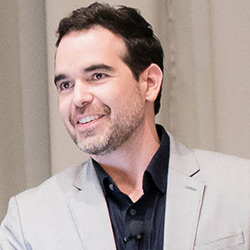Dario Robleto Illustrates Bond Between Science and Art
The McCormick artist-at-large featured at April 8 Dean’s Seminar Series lecture
The marriage of science and art seems like it could be an awkward one. Science is about finding definitive answers, while art’s purpose – to inspire, evoke and communicate -- is harder to define.
But the two disciplines can borrow from each other and even unite to tackle important cultural work, which Dario Robleto illustrated during his virtual April 8 Dean’s Seminar Series lecture presented by Northwestern Engineering and the Mary & Leigh Block Museum of Art.

“The similarities between art and science are really significant,” Robleto said. “At some core level, we’re both interested in increasing the sensitivity of our observations. We both agree that if we can become more aware, more observant, more detailed, and more importantly, more present with each other, that this can lead to new types of discoveries and forms of truth.”
Robleto, a transdisciplinary artist who is the McCormick School of Engineering’s Artist-at-Large, has spent much of his time since assuming that post in 2018 working with faculty in the Northwestern Center for Synthetic Biology. That field has the potential to shape the future by finding ways to test for clean water, creating new proteins, and developing novel techniques to design targeted therapeutics or next-generation materials or chemicals. However, those scientists and engineers involved in synthetic biology must do so in an ethical way.
Discussions about ethics that are honest and interdisciplinary, Robleto said, are worthwhile and must be had.
“Art and science really are both these incredible modes of inquiry into the nature of life and experience, and I feel we have a responsibility to step outside of our comfort zones and communicate in clear and accessible ways not only about our individual topics but to each other,” Robleto said. “It’s not always a given that an artist and a scientist can have a really rich, deep conversation unless we work at it. I think the same goes for the public.
“The argument for the collaborative value of art and science has to be restated, it has to be championed anew, and I think, very importantly, it has to keep adapting with the times.”
Robleto is working on three pieces that cross between science and art.
“The Boundary of Life is Quietly Crossed” is an ever-growing wooden black case that holds death notices for people who were the oldest person on the planet at the time of their passing, artistically documenting the progression of time. What Robleto notices during his research is the knowledge the deceased gained in life. At the same time, Robleto collects data on the supercentenarians’ secrets to longevity, which counterintuitively include chocolate, alcohol, and even smoking.
“The Ark of Frailty” views death and life from a different lens, highlighting Lazarus species--those rediscovered years after being classified as extinct. Displayed in a wooden white case, Robleto’s piece shows “resurrection notices” to commemorate lives that came back. Using the example of the Spix’s macaw, with 52 recently released into the wild despite once declared extinct, Robleto explores the ethics of observing and bringing back a species.
The third ongoing project examines the electricity of our hearts and brains and pull out something that reflects the individual human experience can be extracted. Inspired by Ann Druyan placing heart and brain sounds on the Voyager Golden Record in 1977, Robleto is working with University of Houston engineering professor Jose Luis Contreras-Vidal to explore whether prosthetics can be pushed forward through a brain-computer interface, and eventually if a full life can be decoded via a brain signal. The brain signals are collected by Contreras-Vidal at an exhibition of Robleto’s work.
“If collaboration with an artist can improve prosthetic design and the sense of touch for an amputee, sign me up. I want to be part of that,” Robleto said. “If working with an artist can answer some weird philosophical question about our brain signals and if they are playable at a future date, then I want to tackle that too."
In winter 2023, the Block Museum and McCormick will present an original exhibition of and publication on Robleto’s work, The Aorta of an Archivist.
Read more about Dario Robleto’s work in Northwestern Engineering magazine.